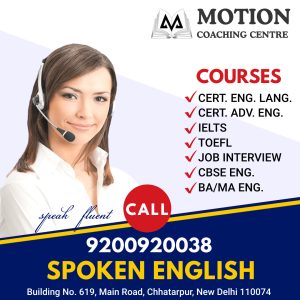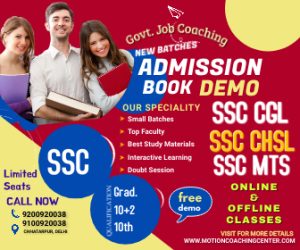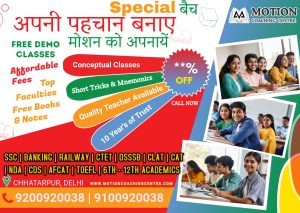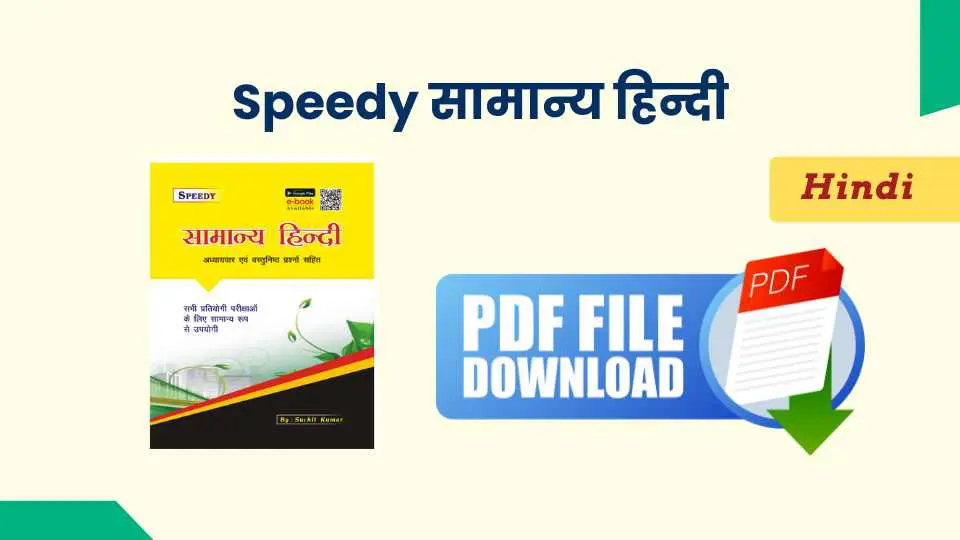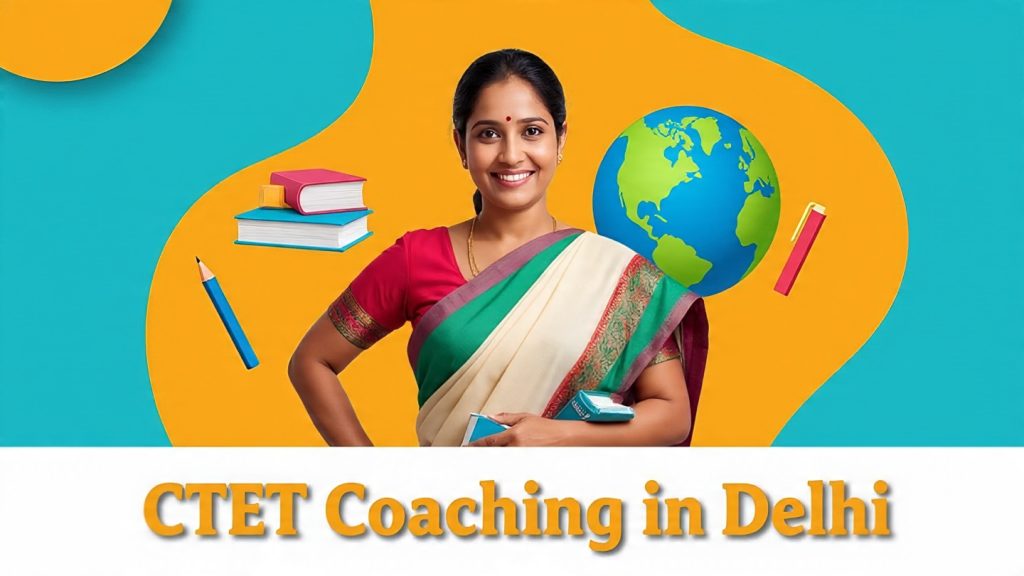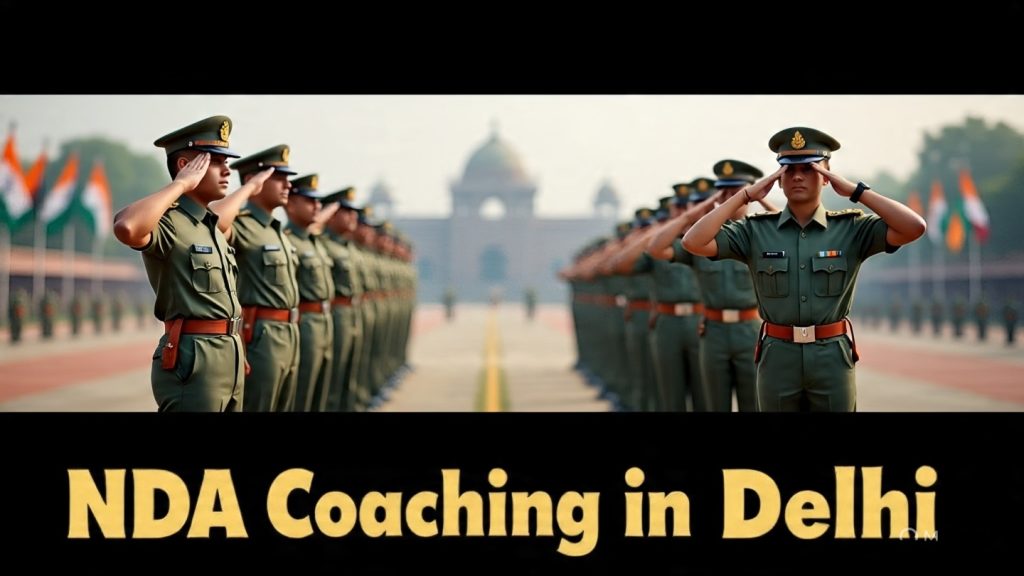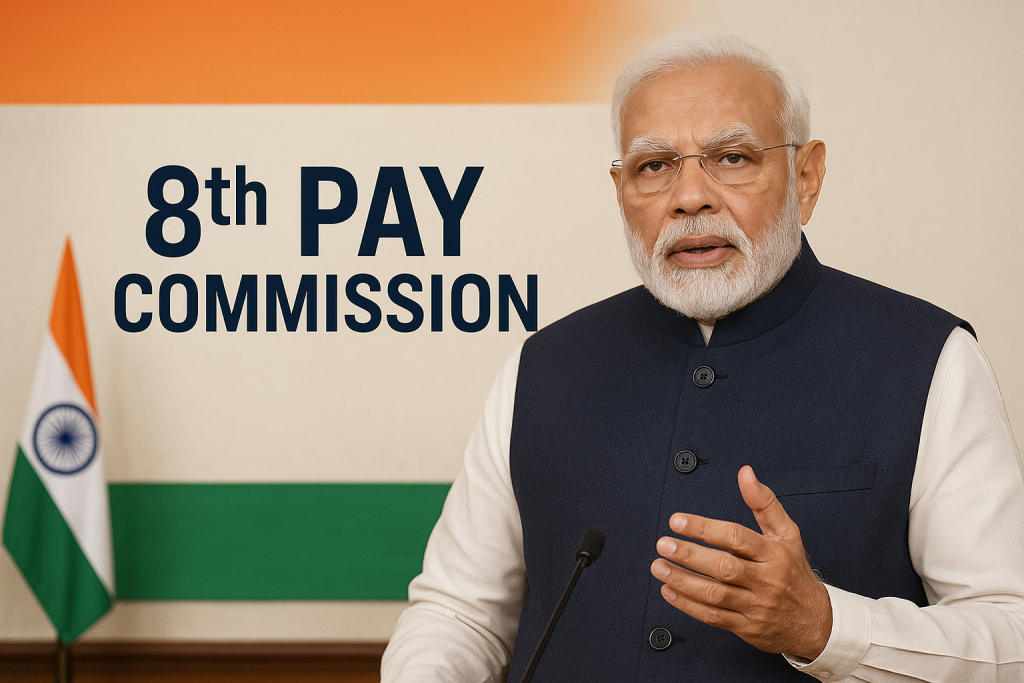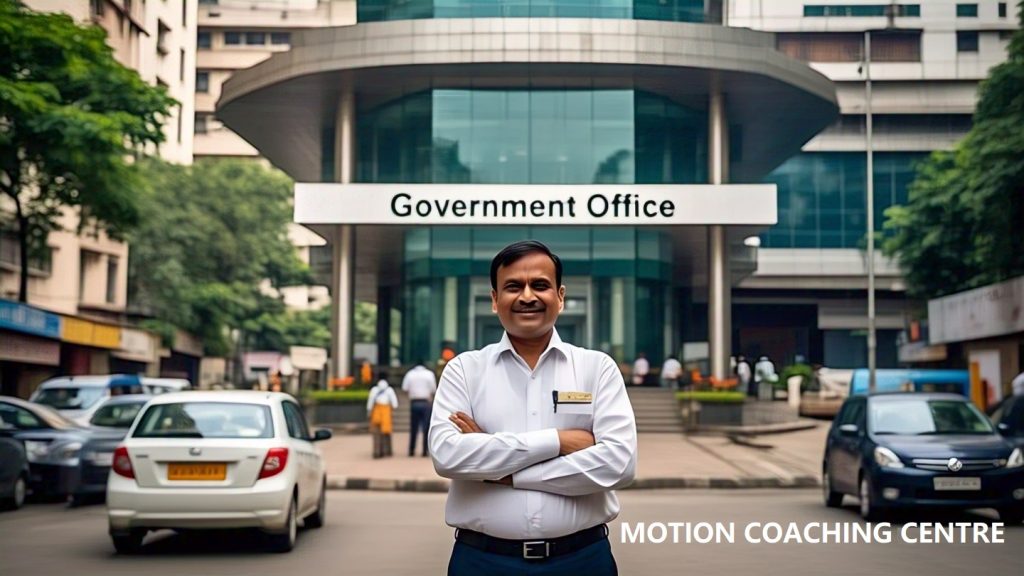SSC CGL Coaching in Delhi
Are you looking for ssc cgl coaching in Delhi then you are at right place because motion coaching centre provides ssc cgl coaching in south Delhi ncr with low fees structure that will make you able to crack ssc examination in minimum attempts.
These staff selection graduate level exams are very tough to crack and need great efforts by aspirants and their teachers. Our top faculties selected by taking multi-level eligibility aspects. They are able to give maximum success rate in our batches of ssc cgl exam coaching south delhi ncr. So we can assure the success of our students with high quality content study material for ssc cgl exams. We have various centers opening in Delhi. We offer limited student batches so every students get personal attention in class.
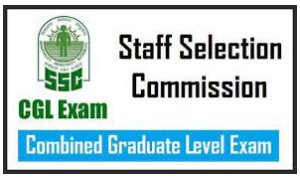
What is SSC CGL Examination ?
SSC CGL stand for Staff Selection Commission Combined Graduate Level Exam is the prominent exam to recruit Class C and B officials in various government departments.
What is the essential qualification for SSC CGL Exam ?
Age limit
An applicant must be between 18 and 32 years old to apply for the post of SSC CGL 2022.
Educational Qualification
An applicant should have possessed a Bachelor’s degree from a recognized College or University. Candidates should study either in Mathematics/ Statistics/ Economics as an elective subject or as a compulsory subject.
How many level of these exams ?
These exams conduct in 4 Tiers :
- Tier 1 – It is the preliminary exam.
- Tier 2 – It is called Main Exam that contains two papers English and Mathematics or Statistics.
- Tier 3 – It is a Descriptive exam where aspirants have to write essay, precis, letter etc.
- Tier 4 – Interview (only for specific posts)
What is the syllabus for SSC CGL Exam ?
SSC CGL Tier-I Exam Pattern
| S No. | Sections | No. of Questions | Total Marks | Time Allotted |
|---|---|---|---|---|
| 1 | General Intelligence and Reasoning | 25 | 50 | A cumulative time of 60 minutes |
| 2 | General Awareness | 25 | 50 | |
| 3 | Quantitative Aptitude | 25 | 50 | |
| 4 | English Comprehension | 25 | 50 | |
| Total | 100 | 200 |
SSC CGL Syllabus for Tier 1
Quantitative Aptitude Syllabus
Quantitative Aptitude questions will be designed to test the ability of appropriate use of numbers and number sense of the candidate. The scope of the test will be computation of whole numbers, decimals, fractions and relationships between numbers, Profit and Loss, Discount, Partnership Business, Mixture and Alligation, Time and distance, Time & Work,Percentage. Ratio & Proportion, Square roots, Averages, Interest, Basic algebraic identities of School Algebra & Elementary surds, Graphs of Linear Equations, Triangle and its various kinds of centres, Congruence and similarity of triangles, Circle and its chords, tangents, angles subtended by chords of a circle, common tangents to two or more circles, Triangle, Quadrilaterals, Regular Polygons, Circle, Right Prism, Right Circular Cone, Right Circular Cylinder, Sphere, Heights and Distances, Histogram, Frequency polygon, Bar diagram & Pie chart, Hemispheres, Rectangular Parallelepiped, Regular Right Pyramid with triangular or square base, Trigonometric ratio, Degree and Radian Measures, Standard Identities, Complementary angles.
General Intelligence and Reasoning Syllabus
General Intelligence and Reasoning includes questions of both verbal and non-verbal type. This component may include questions on analogies, similarities and differences, space visualization, spatial orientation, problem solving, analysis, judgment, decision making, visual memory, discrimination, observation, relationship concepts, arithmetical reasoning and figural classification, arithmetic number series, non-verbal series, coding and decoding, statement conclusion, syllogistic reasoning etc.
The topics are, Semantic Analogy, Symbolic/ Number Analogy, Figural Analogy, Semantic Classification, Symbolic/ Number Classification, Figural Classification, Semantic Series, Number Series, Figural Series, Problem Solving, Word Building, Coding & de-coding, Numerical Operations, symbolic Operations, Trends, Space Orientation, Space Visualization, Venn Diagrams, Drawing inferences, Punched hole/ pattern- folding & un-folding, Figural Pattern- folding and completion, Indexing, Address matching, Date & city matching, Classification of centre codes/roll numbers, Small & Capital letters/ numbers coding, decoding and classification, Embedded Figures, Critical thinking, Emotional Intelligence, Social Intelligence, Other sub-topics, if any.
English Syllabus
This section measures Candidates’ ability to understand correct English, his/ her basic comprehension and writing ability, etc. would be tested. This section may include questions on Phrases and Idioms, One word Substitution, Sentence Correction, Error Spotting, Fill in the Blanks, Spellings Correction, Reading Comprehension, Synonyms-Antonyms, Active Passive, Sentence Rearrangement, Sentence Improvement, Cloze test etc.
General Awareness Syllabus
Questions in this section will be aimed at testing the candidates’ general awareness (GK+GS) of the environment around him and its application to society. The test will also include questions relating to India and its neighbouring countries especially pertaining History, Culture, Geography, Economic Scene, General Policy & Scientific Research. The questions will also be asked from Science, Current Affairs, Books and Authors, Sports, Important Schemes, Important Days, Portfolios,People in News etc.
SSC CGL Tier-II Exam Pattern
| S No. | Sections | No. of Questions | Total Marks | Time Allotted |
|---|---|---|---|---|
| 1 | Quantitative Ability | 100 | 200 | 2 hours |
| 2 | English Language and Comprehension | 200 | 200 | 2 hours |
| 3 | Statistics | 100 | 200 | 2 hours |
| 4 | General Studies (Finance and Economics) | 100 | 200 | 2 hours |
SSC CGL Tier 2 Syllabus
Paper-I (Quantitative Abilities) Syllabus:
The questions will be designed to test the ability of appropriate use of numbers and number sense of the candidate. The scope of the test will be the computation of whole numbers, decimals, fractions and relationships between numbers, Percentage, Ratio & Proportion, Square roots, Averages, Interest, Profit and Loss, Discount, Partnership Business, Mixture and Alligation, Time and distance, Time & Work, Basic algebraic identities of School Algebra & Elementary surds, Graphs of Linear Equations, Triangle and its various kinds of centres, Congruence and similarity of triangles, Circle and its chords, tangents, angles subtended by chords of a circle, common tangents to two or more circles, Triangle, Quadrilaterals, Regular Polygons, Circle, Right Prism, Right Circular Cone, Right Circular Cylinder, Sphere, Hemispheres, Rectangular Parallelepiped, Regular Right Pyramid with triangular or square base, Trigonometric ratio, Degree and Radian Measures, Standard Identities, Complementary angles, Heights and Distances, Histogram, Frequency polygon, Bar diagram & Pie chart.
Paper-II (English Language and Comprehension) Syllabus:
Questions in this section will be designed to test the candidate’s understanding and knowledge of English Language and will be based on spot the error, fill in 21 the blanks, synonyms, antonyms, spelling/ detecting misspelled words, idioms & phrases, one word substitution, improvement of sentences, active/ passive voice of verbs, conversion into direct/ indirect narration, shuffling of sentence parts, shuffling of sentences in a passage, cloze passage & comprehension passage.
Paper-III (Statistics) Syllabus:
1. Collection, Classification and Presentation of Statistical Data – Primary and Secondary data, Methods of data collection; Tabulation of data; Graphs and charts; Frequency distributions; Diagrammatic presentation of frequency distributions.
2. Measures of Central Tendency – Common measures of central tendency – mean median and mode; Partition values- quartiles, deciles, percentiles.
3. Measures of Dispersion- Common measures dispersion – range, quartile deviations, mean deviation and standard deviation; Measures of relative dispersion.
4. Moments, Skewness and Kurtosis – Different types of moments and their relationship; meaning of skewness and kurtosis; different measures of skewness and kurtosis.
5. Correlation and Regression – Scatter diagram; simple correlation coefficient; simple regression lines; Spearman‟s rank correlation; Measures of association of attributes; Multiple regression; Multiple and partial correlation (For three variables only).
6. Probability Theory – Meaning of probability; Different definitions of probability; Conditional probability; Compound probability; Independent events; Bayes‟ theorem.
7. Random Variable and Probability Distributions – Random variable; Probability functions; Expectation and Variance of a random variable; Higher moments of a random variable; Binomial, Poisson, Normal and Exponential distributions; Joint distribution of two random variable (discrete).
8. Sampling Theory – Concept of population and sample; Parameter and statistic, Sampling and non-sampling errors; Probability and nonprobability sampling techniques(simple random sampling, stratified sampling, multistage sampling, multiphase sampling, cluster sampling, systematic sampling, purposive sampling, convenience sampling and quota sampling); Sampling distribution(statement only); Sample size decisions.
9. Statistical Inference – Point estimation and interval estimation, Properties of a good estimator, Methods of estimation (Moments method, Maximum likelihood method, Least squares method), Testing of hypothesis, Basic concept of testing, Small sample and large sample tests, Tests based on Z, t, Chi-square and F statistic, Confidence intervals.
10. Analysis of Variance – Analysis of one-way classified data and twoway classified data.
11. Time Series Analysis – Components of time series, Determinations of trend component by different methods, Measurement of seasonal variation by different methods.
12. Index Numbers – Meaning of Index Numbers, Problems in the construction of index numbers, Types of index number, Different formulae, Base shifting and splicing of index numbers, Cost of living Index Numbers, Uses of Index Numbers.
Paper-IV (General Studies-Finance and Economics):
Part A: Finance and Accounts-(80 marks):
Fundamental principles and basic concept of Accounting:
1.1 Financial Accounting: Nature and scope, Limitations of Financial Accounting, Basic concepts and Conventions, Generally Accepted Accounting Principles.
1.2 Basic concepts of accounting: Single and double entry, Books of original Entry, Bank Reconciliation, Journal, ledgers, Trial Balance, Rectification of Errors, Manufacturing, Trading, Profit & loss Appropriation Accounts, Balance Sheet Distinction between Capital and Revenue Expenditure, Depreciation Accounting, Valuation of Inventories, Non-profit organisations Accounts, Receipts and Payments and Income & Expenditure Accounts, Bills of Exchange, Self Balancing Ledgers.
Part B: Economics and Governance-(120 marks):
2.1 Comptroller & Auditor General of India- Constitutional provisions, Role and responsibility.
2.2 Finance Commission-Role and functions.
2.3 Basic Concept of Economics and introduction to Micro Economics: Definition, scope and nature of Economics, Methods of economic study and Central problems of an economy and Production possibilities curve.
2.4 Theory of Demand and Supply: Meaning and determinants of demand, Law of demand and Elasticity of demand, Price, income and cross elasticity; Theory of consumer‟s behaviourMarshallian approach and Indifference curve approach, Meaning and determinants of supply, Law of supply and Elasticity of Supply.
2.5 Theory of Production and cost: Meaning and Factors of production, Laws of production- Law of variable proportions and Laws of returns to scale.
2.6 Forms of Market and price determination in different markets: Various forms of markets-Perfect Competition, Monopoly, Monopolistic Competition and Oligopoly ad Price determination in these markets.
2.7 Indian Economy:
2.7.1 Nature of the Indian Economy Role of different sectorsRole of Agriculture, Industry and Services-their problems and growth.
2.7.2 National Income of India-Concepts of national income, Different methods of measuring national income.
2.7.3 Population-Its size, rate of growth and its implication on economic growth.
2.7.4 Poverty and unemployment- Absolute and relative poverty, types, causes and incidence of unemployment.
2.7.5 Infrastructure-Energy, Transportation, Communication.
2.8 Economic Reforms in India: Economic reforms since 1991; Liberalisation, Privatisation, Globalisation and Disinvestment.
2.9 Money and Banking:
2.9.1 Monetary/ Fiscal policy- Role and functions of Reserve Bank of India; functions of commercial Banks/RRB/Payment Banks.
2.9.2 Budget and Fiscal deficits and Balance of payments.
2.9.3 Fiscal Responsibility and Budget Management Act, 2003.
2.10 Role of Information Technology in Governance.
SSC CGL Tier-III Exam Pattern
| Subject | Marks | Time |
|---|---|---|
| Descriptive Paper in English/Hindi (Writing of Essay, Precis, Letter, Application etc.) | 100 marks | 1 hour or 60 minutes |
SSC CGL Tier-IV Syllabus (Skill Test)
Tier-IV examination comprises of couple of skill sets required for certain Government Posts all over the country.
DEST (Data Entry Speed Test): For the post of Tax Assistant (Central Excise and Income Tax),DEST Exam through SSC CGL 2021 exam is conducted to check the typing speed of the candidate. The candidates are given an article in English which they have to type on Computer. A candidate is required to type 2000 words in 15 minutes.
CPT (Computer Proficiency Test): Word Processing, Spread Sheets and Generation of slides are the three modules that are important for this exam and the commission demands a candidate to be proficient in it for the post of CSS, MEA, Inspector (Central Excise), Inspector (Preventive Officer), Inspector (Examiner).
Is there any penalty for wrong answers ?
Yes, Giving a wrong answer to a question will lead to deduction of 0.5 marks in Tier – I exam.
In Tier-II, there will be negative marking of 0.25 for each wrong answer in Paper-II (English Language and Comprehension) and of 0.50 marks for each wrong answer in Paper-I, Paper-III and Paper-IV.
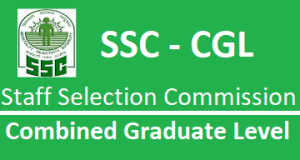
Why Motion Coaching Centre?
We achieved high success rate per batch of selection in various ssc cgl exams in India. Our focus on quality education. We give till selection commitment to students and assure this success with our efforts. Our course materials and faculty always dedicated to make the dreams true of their students. We provide offline and online test series that and give weekly full practice set paper at our centers.



